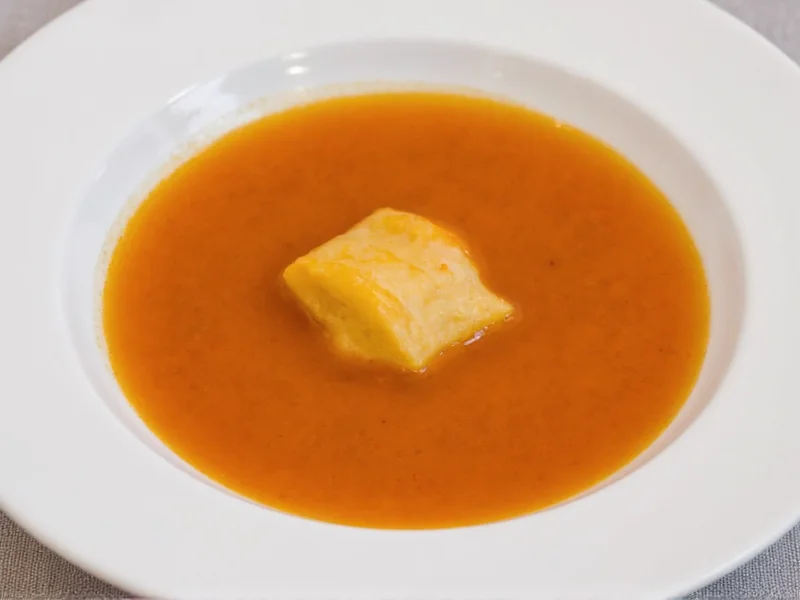Understanding Soup Terrines: Beyond the Basic Definition
When exploring what is a soup terrine, it's essential to recognize its dual meaning in culinary contexts. The term describes both the specialized container and the preparation technique. Originating from French cuisine, the word "terrine" comes from "terre" (earth), referencing the traditional earthenware vessels used for centuries.
Professional chefs emphasize that the difference between soup and terrine lies primarily in preparation method and serving temperature. While most soups are served hot immediately after cooking, terrines are typically assembled in their namesake dish, then chilled to allow flavors to develop fully. This slow melding process creates a more sophisticated flavor profile that casual soup preparations often miss.
| Characteristic | Soup Terrine | Traditional Soup |
|---|---|---|
| Preparation Time | 24-48 hours (including chilling) | 30-90 minutes |
| Serving Temperature | Chilled (typically 40-50°F/4-10°C) | Hot (typically 160-180°F/70-82°C) |
| Texture | Smooth, refined, often gelatinous | Variable, often chunkier |
| Flavor Development | Complex, layered from slow melding | Immediate, straightforward |
| Typical Presentation | Served directly from terrine vessel | Bowls or cups |
Types of Soup Terrines and Their Culinary Applications
Chefs specializing in French cuisine identify three primary categories of soup terrine recipes that home cooks should understand. The classic terrine froide (cold terrine) represents the most traditional approach, featuring ingredients like aspic, vegetables, and delicate proteins set in a savory jelly. These require precise temperature control during preparation to achieve the perfect set without becoming rubbery.
Modern interpretations include warm soup terrines, which maintain the vessel's distinctive presentation but serve the soup at traditional hot soup temperatures. This variation bridges the gap between traditional terrines and contemporary dining expectations, particularly during colder months when chilled soups feel less appropriate.
Regional adaptations have emerged globally, with chefs incorporating local ingredients while maintaining the terrine's essential characteristics. In Mediterranean cuisine, you'll find vegetable soup terrines featuring roasted peppers and eggplant, while Asian interpretations might include delicate fish terrines with miso and ginger infusions.
Mastering Soup Terrine Preparation Techniques
Creating an exceptional soup terrine requires attention to specific technical details that distinguish it from standard soup making. The best ingredients for soup terrine preparations share certain qualities: clarity of flavor, complementary textures, and the ability to meld harmoniously during the chilling process.
Professional chefs recommend starting with a crystal-clear consommé or carefully strained broth as the foundation. This base provides the necessary transparency that showcases the terrine's layered ingredients. When considering how to make soup terrine properly, the layering technique proves critical—each component should be added at precise temperatures to prevent mixing while still bonding appropriately.
Temperature control represents perhaps the most challenging aspect of terrine preparation. The ideal chilling process occurs gradually in a refrigerator set between 34-38°F (1-3°C). Rapid chilling creates condensation that dilutes flavors and disrupts the delicate layers. Most experienced chefs allow 24-36 hours for complete setting, with the first 4 hours being particularly crucial for establishing clean layers.
Serving Soup Terrines: Presentation and Pairing Guidance
Proper presentation transforms a well-prepared soup terrine from a simple dish into a culinary experience. The traditional method involves serving directly from the terrine vessel, preserving the careful layering that defines this preparation style. When executing how to serve soup terrine professionally, chefs recommend chilling both the terrine and serving spoons to maintain the delicate temperature balance.
Accompaniments should complement without overwhelming the terrine's subtle flavors. Classic pairings include:
- Thinly sliced baguette with unsalted butter
- Simple green salad with vinaigrette
- Light-bodied white wine (for fish-based terrines)
- Dry rosé (for vegetable terrines)
Seasoned chefs note that the best soup terrine recipes balance richness with acidity. A small splash of lemon juice or vinegar added just before serving can elevate the entire dish, cutting through any potential heaviness from gelatin or fats. This technique proves especially valuable for heartier meat-based terrines that might otherwise feel cloying.
Avoiding Common Soup Terrine Preparation Mistakes
Even experienced home cooks encounter challenges when attempting soup terrine vs regular soup preparations. The most frequent error involves improper temperature management during assembly. Adding warm components to a chilled base (or vice versa) creates unwanted mixing that destroys the distinctive layered appearance.
Another common issue relates to seasoning. Because flavors concentrate during the chilling process, many beginners overseason their terrines. Professional chefs recommend seasoning each component individually at 75% of normal intensity, then performing a final adjustment after the terrine has set for 12 hours.
Texture problems represent the third major challenge. An improperly set terrine might be too firm (rubbery) or too soft (soupy). The solution lies in precise gelatin measurement—typically 1.5-2 teaspoons of powdered gelatin per quart of liquid, bloomed properly before incorporation. For vegetarian options, agar-agar provides a reliable alternative with similar setting properties.
Seasonal Soup Terrine Variations for Year-Round Enjoyment
Understanding different types of soup terrines allows chefs to create seasonal specialties that showcase peak ingredients. Spring brings delicate asparagus and pea terrines with mint infusions, while summer features vibrant tomato-watermelon combinations with basil.
Fall inspires earthy mushroom and root vegetable terrines with thyme and sage, and winter calls for heartier preparations featuring game meats or rich seafood combinations. The versatility of the terrine format makes it adaptable to virtually any seasonal ingredient while maintaining its distinctive preparation method and presentation style.











 浙公网安备
33010002000092号
浙公网安备
33010002000092号 浙B2-20120091-4
浙B2-20120091-4